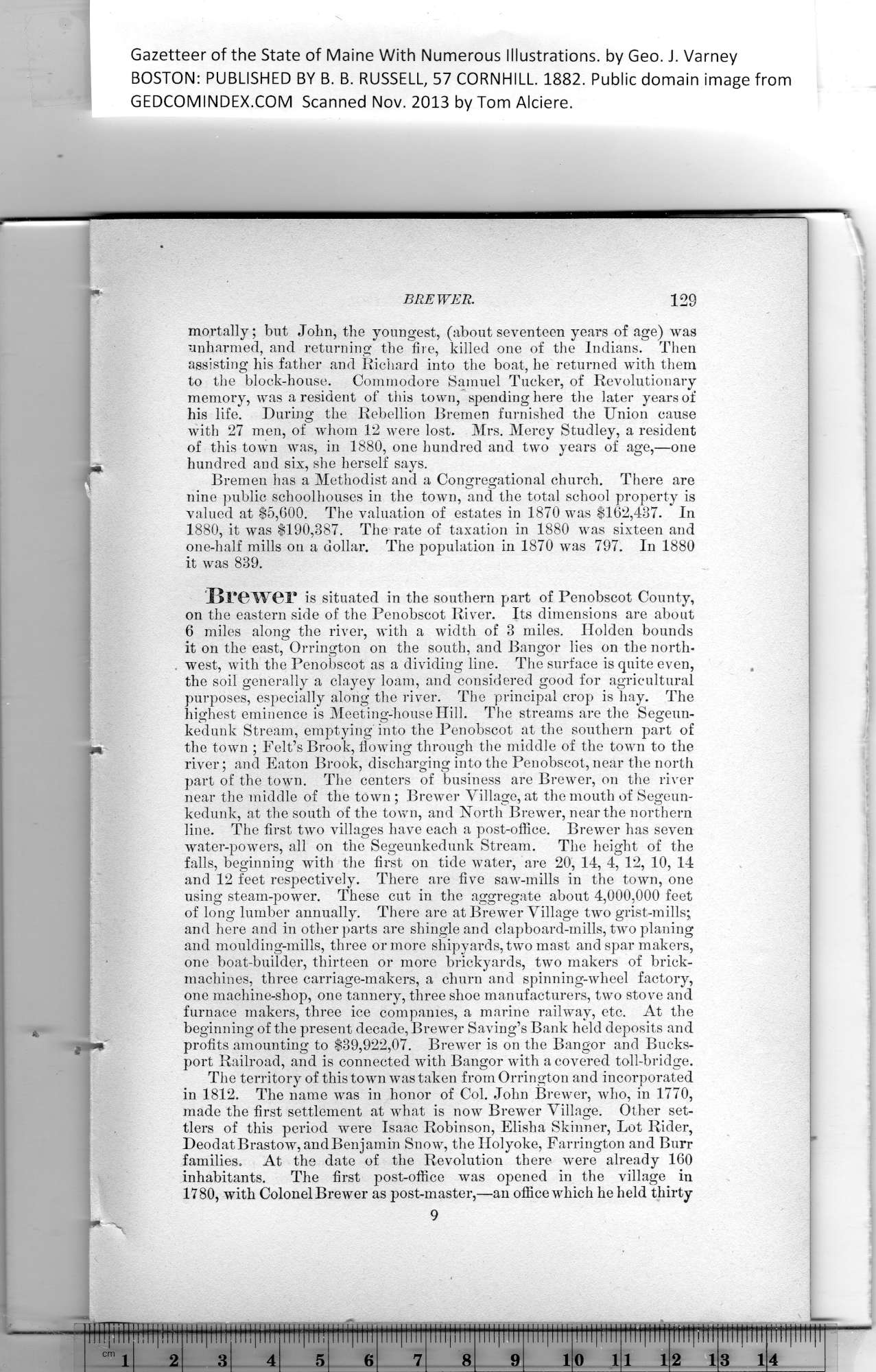|
Gazetteer of the State of Maine With Numerous Illustrations, by Geo. J. Varney
BOSTON: PUBLISHED BY B. B. RUSSELL, 57 CORNHILL. 1882. Public domain image from
BREWER.
mortally; but John, the youngest, (about seventeen years of age) was
unharmed, and returning the fire, killed one of the Indians. Then
assisting his father and Richard into the boat, he returned with them
to the block-house. Commodore Samuel Tucker, of Revolutionary
memory, was a resident of this town, spending here the later years of
his life. During the Rebellion Bremen furnished the Union cause
with 27 men, of whom 12 were lost. Mrs. Mercy Studley, a resident
of this town was, in 1880, one hundred and two years of age,—one
hundred and six, she herself says.
Bremen has a Methodist and a Congregational church. There are
nine public schoolhouses in the town, and the total school property is
valued at $5,600. The valuation of estates in 1870 was $162,437. In
1880, it was $190,387. The rate of taxation in 1880 was sixteen and
one-half mills on a dollar. The population in 1870 was 797. In 1880
it was 839.
Brewer is situated in the southern part of Penobscot County,
on the eastern side of the Penobscot River. Its dimensions are about
6 miles along the river, with a width of 3 miles. Holden bounds
it on the east, Orrington on the south, and Bangor lies on the north-
west, with the Penobscot as a dividing line. The surface is quite even,
the soil generally a clayey loam, and considered good for agricultural
purposes, especially along the river. The principal crop is hay. The
highest eminence is Meeting-house Hill. The streams are the Segeun-
kedunk Stream, emptying into the Penobscot at the southern part of
the town ; Felt’s Brook, flowing through the middle of the town to the
river; and Eaton Brook, discharging into the Penobscot, near the north
part of the town. The centers of business are Brewer, on the river
near the middle of the town ; Brewer Village, at the mouth of Segeun-
kedunk, at the south of the town, and North Brewer, near the northern
line. The first two villages have each a post-office. Brewer has seven
water-powers, all on the Segeunkedunk Stream. The height of the
falls, beginning with the first on tide water, are 20, 14, 4, 12, 10, 14
and 12 feet respectively. There are five saw-mills in the town, one
using steam-power. These cut in the aggregate about 4,000,000 feet
of long lumber annually. There are at Brewer Village two grist-mills;
and here and in other parts are shingle and clapboard-inills, two planing
and moulding-mills, three or more shipyards, two mast and spar makers,
one boat-builder, thirteen or more brickyards, two makers of brick-
machines, three carriage-makers, a churn and spinning-wheel factory,
one machine-shop, one tannery, three shoe manufacturers, two stove and
furnace makers, three ice companies, a marine railway, etc. At the
beginning of the present decade, Brewer Saving’s Bank held deposits and
profits amounting to $39,922,07. Brewer is on the Bangor and Bucks-
port Railroad, and is connected with Bangor with a covered toll-bridge.
The territory of this town was taken from Orrington and incorporated
in 1812. The name was in honor of Col. John Brewer, who, in 1770,
made the first settlement at what is now Brewer Village. Other set-
tlers of this period were Isaac Robinson, Elisha Skinner, Lot Rider,
DeodatBrastow, and Benjamin Snow, the Holyoke, Farrington and Burr
families. At the date of the Revolution there were already 160
inhabitants. The first post-office was opened in the village in
1780, with Colonel Brewer as post-master,—an office which he held thirty
PREVIOUS PAGE ... NEXT PAGE
This page was written in HTML using a program written in Python 3.2
|
